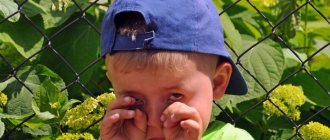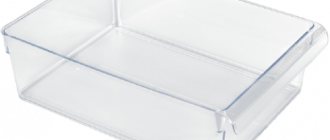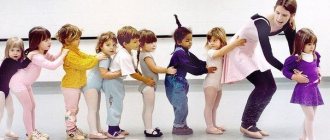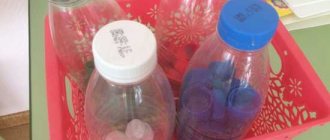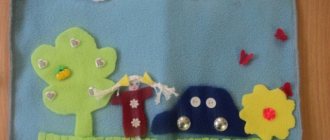A set of sand therapy classes during the adaptation period of infants and young children.
A set of sand therapy classes during the adaptation period of infants and young children.
What do you need to play in the sand? But, in essence, so little is needed: Love, desire, kindness, So that faith in Childhood does not disappear.
Let's paint the simplest drawer from a table with blue paint, A handful of golden sand will flow into it like a wondrous fairy tale.
A set of small toys Let's take it into the game... Like God We will create our own World of Wonders, Having walked the path of Knowledge.
When entering a preschool educational institution, all children experience adaptation stress.
The adaptive capabilities of a young child are limited, so a sudden transition of a child to a new social situation and a prolonged stay in a stressful state can lead to emotional disturbances or a slowdown in the rate of psychophysical development.
Thus, an important task for teachers is to help children overcome stress when entering a preschool institution and successfully adapt to it.
One of the effective means of adaptation is “ Sand therapy ”
. Sand therapy is a type of play therapy.
Young children often cannot express their experiences due to the lack of active speech. Sand therapy may be useful for establishing mutual understanding with peers, adults and the new environment during the adaptation period. Sand therapy also stabilizes the child’s psycho-emotional state.
When working with children, it is recommended to use simple exercises that are based on such characteristics of young children as: emotionality, impressionability, the ability to quickly become infected, both positive and negative, by emotions from adults and peers and imitate their actions.
Each lesson using the sand therapy method has its own structural features:
1. Warm-up (or warm-up games)
. The stage of touching and playing on the surface of dry sand.
Goal: reduction of psychophysical stress, regulation of muscle tension, relaxation, development of tactile sensitivity, imagination, consolidation of knowledge about sensory standards.
At the stage of touching the surface of dry sand, the following games and exercises are used:
- Game “Hello Sand!”
— Game “Sand Rain”
— Exercise “Sand wind”
— Game “Unusual Traces”
.
2. Directly training part.
Goal: development of sensory abilities, object-practical manipulations, fine motor skills, cognitive and speech activity.
Games:
Game "Sand Hide and Seek"
Game “Hide the toys”
Game "Children's secrets"
Exercise “Funny fingers”
and etc.
3. Final stage. The stage of touching and playing on the surface of wet sand.
The purpose of sand therapy is methodological development (junior group) on the topic
The main goal of sand therapy is to relieve psycho-emotional stress, develop tactile sensitivity, and create a positive emotional mood. To achieve this goal, various games and exercises with kinetic sand are used: “Sand Rain”, “Footprints on the Path”, “Magic Hill”, “Gates and Fences”, “Find and Name”, turns a correctional and developmental activity into an interesting and exciting one. a game during which children, emotionally liberated, actively and freely express their emotions and mood in sand buildings.
The use of this therapeutic agent, like sand, helps to correct antisocial behavior in preschool children, relieve symptoms of anxiety, hyperreactivity, isolation, develop the ability to express feelings, increase self-esteem and build self-confidence. Sand develops fine motor skills of the hands, has a beneficial effect on tactile sensations, and also soothes and relaxes the muscles of the hands. Properly selected games and exercises with sand help relieve psycho-emotional stress, as well as the development of interhemispheric interaction.
Kinetic Sand is sand that is something between plasticine and sand from a sandbox. You can sculpt various shapes from it or cut them out using molds, and then with one movement of your hand it will turn back into a crumbly sandy mass. Sand does not harden and does not cause allergic reactions. It does not crumble into small grains and does not leave greasy marks like plasticine. The magical texture of the mass is so pleasant to the touch and incredible in its effects that it fascinates children and adults no less than building sand castles on the sea coast. Children are satisfied with an interesting game, and adults do not worry about the dirty furniture, room and hands of the child.
Sand therapy is useful if the child:
- poor sleep, nightmares;
- poorly developed fine motor skills;
- hysterics, disobedience, whims;
- logoneurosis (stuttering), speech development delays, as well as other speech problems;
- shyness, lack of self-confidence;
- aggression, anxiety;
- there is no mutual understanding with parents;
- neurotic disorders;
- urinary or fecal incontinence (enuresis, encopresis);
- psychosomatic diseases;
- fear of school, kindergarten;
- frequent tearfulness (for no reason);
- The child has experienced severe stress.
The results are individual and depend on the goals set at the beginning of the correction course:
- The general emotional state of the child will improve;
- Fears, negative emotions, worries will go away;
- Development of imagination, creative potential;
- Development of thinking, speech, memory, attention, fine motor skills;
- Development of self-esteem and self-confidence;
- Adaptation to a new environment (kindergarten, school);
- Improving relationships with parents and peers;
- Formation of positive character traits.
SAND THERAPY (ART THERAPY) + VIDEO LESSON WITH OKSANA MIKHAILOVA
History of the method
Even before the advent of sand therapy and art therapy, Carl Gustav Jung, the founder of analytical psychology, in addition to psychoanalysis sessions, paid great attention to the work of patients with books on art.
A particularly striking example was Rockefeller’s daughter Edith, when the girl fell into depression due to the emptiness of her life.
She learned to draw and compare images from her dreams with works of art.
Edith began to engage in creativity, transformed, became more sophisticated and cheerful.
Jung's followers created the sand therapy method. The sand paintings created by the children were a reflection of their thoughts and experiences, which became a discovery in psychotherapy.
Features of the method (what are the benefits):
A special feature of the method is that artistic images reflect all subconscious processes, including fears, memories, conflicts and dreams.
For children, this is simply an irreplaceable environment where they can gently come into contact with what worries or frightens them, act out these scenarios and gain new experiences in a safe environment.
Working with sand taps into the child's inner, inner resources and is closely linked to his ability to self-heal and be creative.
This helps you understand yourself and be more successful in a constantly changing world.
Objectives of the method (what problems it solves):
Sand therapy is a powerful technique that has no contraindications.
It works great with adults, but it literally works wonders with kids!
It helps to play out unlived emotions, give vent to true feelings and thoughts,
release aggression in a peaceful manner, improve communication, cope with fears, increase self-esteem and simply enjoy the process!
Principles of the method (how it works):
With the help of a sandbox and small figures, the baby plays out a situation that worries him.
Drawing a picture out of sand or playing, the baby opens up and at this moment his inner world appears,
Invite your child to turn into a wizard and create his own world or an entire planet, a magical forest or a city of the future,
everything that best suits the baby’s age, giving him complete freedom of action in his flight of fancy!
You can show how to build sand landscapes, create rivers and seas, and use tree and animal figures.
Turn off your inner critic and create together, giving complete freedom to your imagination,
then you will come up with a lot of new and wonderful games that can easily be implemented in the sandbox!
Everything is possible here!
And the child will surprise you with his imagination and approach to business!
Through such games, energy is released for development and learning.
In other words, the child returns his own inner strength.
Indications for therapy. Requirements for a teacher:
When to contact a specialist?
These are cases when you notice that for no apparent reason the child’s appetite or sleep is disturbed.
If you notice that your child is overly withdrawn, shy or fearful.
When, after events affecting the life of a child, you observe a sharp change in the child’s behavior or mood.
Here it is worth clarifying the situation with a psychologist.
When choosing a specialist, be sure to pay attention to his experience and education so as not to harm the child.
Psychologist's advice to parents: how to decipher the signs
In order for the process of playing in the sandbox to benefit the child, give him complete freedom of action and creativity - the child himself can choose which toys he wants to put in the sandbox and what to do with them.
This is your child’s world, and in it he is the rightful owner - he buries whomever he wants, whom he wants to elevate -
expresses his thoughts and feelings in words, and the parents here simply observe what is happening.
Leave advice and let him express his feelings.
Help only if the baby asks you to do so!
You can find out what is happening in his world, or comment on something, using the right questions:
- These are open questions.
For example: - who is this? Instead of asking: what kind of monster is this?
For you it may be a monster, but for a child it may be a positive character or even a savior.
- Obvious questions.
Reflect what is happening in the sandbox, but without criticism.
For example: if you see that in a child’s sandbox there is a tree on which a rabbit lives, you can ask him a question: I see that your rabbit lives in a tree?
The child will be happy to answer you - is this so, or maybe the rabbit got in there for some other reason.
But if you argue that this does not happen and teach that rabbits do not live in trees, but live in holes, and everything is wrong in the child’s game, then this can work to reduce the child’s self-esteem and prohibit him from expressing himself creatively.
- The child's reflected responses.
For example, you asked: “Who is this?” - Cat. -Where is this cat going? — She goes to her friend.
And here you begin to mirror: I see that the cat has gone to its friend.
At this moment, the child will see that you are attentive and respectful to his play, that you hear what he says, and that you accept it as it is, without trying to correct or teach.
When we are allowed to be natural, to be ourselves, the process of healing and harmonization occurs.
After some time after such games, you will notice that the child’s emotional state and behavior have changed. Everyone has their own deadline, but if the game is built correctly, it will happen.
This will mean that the new experience that the child acquired in playing with sand has become integrated into the system of his worldview and began to manifest itself in real life.
VIDEO LESSON WITH OKSANA MIKHAILOVA “ELEMENTS OF ART THERAPY”
FULL COLLECTION OF SAND DRAWING AND ART THERAPY LESSONS - HERE
The sand therapy method is gaining popularity among practicing psychologists. Appearing within the framework of analytical psychology, sand therapy developed for a long time within the framework of this concept, remaining a tool of Jungian psychotherapists. Today, the method is used by specialists in various fields (often adding something new to it that allows the method to be used within other concepts) - in fairy tale therapy, art therapy, psychodrama, and as a medium for correctional and developmental activities.
Sand therapy helps a person turn to his inner world, immerse himself in it to search for answers to pressing questions, individual guidelines and resources, and inner meanings. During sand therapy sessions, a person gains access to unconscious parts of the Self, which leads to the release of psychic energy and promotes awareness of the integrity of the individual. A person has the opportunity to establish connections between his body, consciousness and the unconscious, to eliminate the causes of many somatic problems. The main reasons why specialists often choose this method:
- Complex impact on humans;
- Sand therapy can work on a person on several levels;
- A meditative state that relieves stress;
- Appeal to the personal unconscious to resolve intrapersonal conflicts;
- Addressing the collective unconscious through the interpretation of symbols.
In the context of the profound influence of sand therapy on the client’s psyche, the question arises about the need for special training for sand therapists. Today there is a wide range of educational programs covering the theoretical and practical aspects of sand therapy. Of course, turning to the Jungian interpretation of symbols requires a lot of preparation, appropriate training and experience. The main task of the practitioner is to provide the safest possible space (from a psychological point of view), because manipulation in the sandbox is a person’s conversation with himself, and this is the main prerequisite and key to real life changes.
Width of target audience Sand therapy is actively used in working with adults and children. Many specialists use sand exercises in the context of developmental activities; sand exercises are especially effective for speech disorders, insufficient development of the intellectual sphere, and minimal brain dysfunction. In children's groups, it is possible to conduct group classes with sand, in which the positions of team members, situational communication style, and group dynamics are revealed.
Variety of problems to be solved And yet, the main thing is why specialists in various fields turn to sand therapy - in the sandbox space it is possible to solve a wide variety of problems. In the sand space, fantasy develops and the creativity of the individual is actualized, suppressed emotions are brought to a conscious level, the psycho-emotional state is harmonized, current conflicts are played out and lived through, and adaptation potential is activated. The sandbox fits well into the work of an art therapist, a special psychologist, a business consultant, a trainer, and a special education teacher.
Depending on the tasks, different sand and various sandboxes can be used. A classic Jungian sandbox, made of natural wood, having standard dimensions (50*70*8) and a rectangular shape, can be used for almost any activity.
The sides and bottom, symbolizing the sky and water, are usually painted blue, which has great symbolic meaning in analytical psychology. Although some experts consider it advisable to use colored boards placed on the bottom and sides of the sandbox to change the color background of the sand composition (1). The sandbox fits perfectly into individual consultations, however, due to its size, it cannot always be used in group work.
To use a sandbox in a group, a unique round sandbox is more suitable, around which several people can comfortably stand, being at the same distance from the center of the sandbox, which usually carries the greatest semantic load. The round shape of the sandbox brings a special symbolic meaning to the sand manipulation process. The circle is an ancient symbol used in various cultures to denote the most important transcendental concepts: space, time, life. The circle line has neither beginning nor end, which contributes to the perception of “sand space” as a space initially endowed with internal harmony.
Movement in a circle, symbolizing constant return, in the context of sand therapy personifies its main task - the movement of a person towards himself, understanding and accepting his own essence, connecting his past and present into a single whole for harmonious development in the future. People standing around the sandbox find themselves in the same symbolic “circle,” which provokes maximum openness between the participants in the lesson and promotes group cohesion. Also, some experts advise using round sandboxes at the final stage of therapy to consolidate the achieved success (1).
A sandbox that can change color (Tablet for Sand-art and color therapy) is perfect for developing a person’s creative potential.
The well-known relaxation properties of sand, which can relieve internal tension, are enhanced by the inclusion of color - a powerful subconscious source of associations. The world-famous author of the science of color choices, M. Luscher, calls color a “visualized language of feelings” that can reveal subconscious impulses and motives in the language of color symbols (2). The main therapeutic manipulations implemented in the color sandbox are sand painting - one of the most popular methods of art therapy, which promotes the release of subconscious energy through individual images, allowing you to reflect strong emotional states.
Also, activities with this sandbox contribute to the development of fine motor skills and imaginative thinking. Surrounded by waves of color, a person seems to find himself in a fairy tale, where he is the main fairy-tale character, his hands themselves reach out to the sand, which can realize any fantasy in the form of a drawing and just as easily destroy it, because in sand therapy, as in a fairy tale, the hero is omnipotent.
It is also necessary to dwell on the therapeutic properties of sand. Associated with eternity, it evokes amazing sensations in a person, sand paintings are easily built, easily destroyed, sand becomes equal, one sketch is replaced by another, the old gives way to the new. A person, being the author of sand paintings, receives a wonderful psychotherapeutic experience of change, which he can successfully transfer into his life.
The use of different sand is also determined by the main objectives of the lesson. Typically, sand therapy uses purified calcined sand, which must be changed from time to time.
Today, “live sand” is becoming increasingly popular. Developed in Sweden, kinetic sand has a number of features that have made it popular throughout the world. The sand has a unique composition, due to which it feels like wet sand, but at the same time it does not get dirty, does not crumble, but “flows through your fingers” and perfectly retains its given shape. The amazingly beautiful sand paintings that are made from this material stimulate imagination and make the author feel like a real artist. Pleasant to the touch, light and viscous, sand combines the properties of many therapeutic materials that are usually used for relaxation exercises and the development of fine motor skills: clay, dough, plasticine. Sand can take part in all types of children's developmental and correctional activities, influencing the child in a comprehensive manner; it promotes the development of spatial thinking and imagination, ensures synchronization of hand work, develops tactile sensitivity and promotes concentration. Classes with such sand will be very effective for children with attention deficit hyperactivity disorder (ADHD), for children with speech disorders and mental retardation, for children with traumatic experiences. Sand is non-toxic, does not cause allergies, and retains its properties for up to 5 years. However, as practice shows, the relaxation properties of kinetic sand also resonate with adult audiences.
Dipping his hands into the sand, a person is mentally transported to many years ago, when free creativity and knowledge of the world were the absolute norm for him, and playing with molds was the most important activity. Anxiety subsides, symptoms of chronic stress disappear, mood and self-confidence improve. Living sand promotes internal relaxation and activation of creativity.
Bibliography:
- Zinkevich-Evstigneeva T.D., Grabenko T.M. Miracles on the sand. Workshop on sand therapy. – St. Petersburg: Rech, 2010.
- Lusher M. Personality signals. – Voronezh, 1993.
Ananyeva E.A. — postgraduate student of the Department of Special Psychology at St. Petersburg State University, head of the scientific and methodological department of LLC “Imaton” Professional psychological tools.”
Game "A Stream Flows"
“Enchanted City” - sadness “Hello Sand”, “Sand Hide and Seek” Exercise “Winner of Anger” December “The world in reverse” - surprise Game “Getting to know the wet sand.” Game “Creating a Magic Circle in the Sand using small objects (shells, beads, beans.)»
“Bird” - boasting Game “Ask for a toy” Game “Unusual footprints” “Bee” - fear “Good wizards” Game “Sand rain”, “Horse” - whims “Circus on the sand” Game “Hands” January “Brothers” - courage and cowardice “Speak!” Game “Paths made of sand” “Grandfather and granddaughter” - mutual assistance “Archaeology” “Building castles from very wet sand” “Squirrels” - ability to negotiate “Find the difference” "Hello big shot" “Orange” - friendship “Sand Hide and Seek” “Sensitive Fingers” February “Kindergarten” - timidity “Shouters, Whispers, Silencers” “Spontaneous Drawing” “Meeting a Friend” – Joy “Find the Difference” “Draw Joy” “Theater of Moods” -joy “Praises” “Dance of hands” “Two girlfriends” -joy and sadness “Drawing a pictogram of sadness and joy” “Pourring sand from different containers” March “Like a kitten got lost” -fear “Sand paths” “Secret tasks” “Broken vase” "-overcoming fearMAGAZINE Preschooler.RF
Sand therapy as a means of adaptation for young childrenMunicipal preschool educational institution "Kindergarten of a combined type No. 131" of the Kirovsky district of Saratov
Teacher-psychologist of the highest qualification category Matveeva Tatyana Sergeevna, Saratov
What do you need to play in the sand? But, in essence, so little is needed: Love, desire, kindness, So that faith in Childhood does not disappear.
Let's paint the simplest drawer from a table with blue paint, A handful of golden sand will flow into it like a wondrous fairy tale.
A set of small toys Let's take it into the game... Like God We will create our own World of Wonders, Having walked the path of Knowledge.
When entering a preschool educational institution, all children experience adaptation stress.
The adaptive capabilities of a young child are limited, so a sudden transition of a child to a new social situation and a prolonged stay in a stressful state can lead to emotional disturbances or a slowdown in the rate of psychophysical development.
Thus, an important task for teachers is to help children overcome stress when entering a preschool institution and successfully adapt to it.
One of the effective means of adaptation is “Sand therapy” . Sand therapy is a type of play therapy.
The possibilities of sand therapy are multifaceted, but today I would like to dwell only on its advantages associated with the adaptation of young children to new living conditions.
Young children often cannot express their experiences due to the lack of active speech. Sand therapy may be useful for establishing mutual understanding with peers, adults and the new environment during the adaptation period. Sand therapy also stabilizes the child’s psycho-emotional state.
When working with children, it is recommended to use simple exercises that are based on such characteristics of young children as: emotionality, impressionability, the ability to quickly become infected, both positive and negative, by emotions from adults and peers and imitate their actions.
There is a large range of exercises and games with wet and dry sand. With hands immersed in the sand and on its surface. Having studied the literature on this problem, I came to the conclusion that, first of all, you need to use games on the surface of dry sand. Of particular interest to me are games such as:
- "Our Handprints"
- "The cubs are coming"
- “Bunny Jumping”, etc.
I also offer it to children
- slide your palms along the surface of the sand, performing zigzag and circular movements (like cars);
- walk along the surface of the sand with each finger alternately with your right and left hand (you can group your fingers in groups of two, three, four, etc.)
Each lesson using the sand therapy method has its own structural features:
1. Warm-up (or warm-up games). The stage of touching and playing on the surface of dry sand.
Goal: reduction of psychophysical stress, regulation of muscle tension, relaxation, development of tactile sensitivity, imagination, consolidation of knowledge about sensory standards.
At the stage of touching the surface of dry sand, I use games and exercises such as:
- Game "Hello Sand!"
- Game "Sand Rain"
- Exercise “Sand Wind”
- Game "Unusual Traces" .
2. Directly training part.
Goal: development of sensory abilities, object-practical manipulations, fine motor skills, cognitive and speech activity.
At this stage I am using games:
- Game "Sand Hide and Seek"
- Game “Hide the toys”
- Game "Children's secrets"
- Exercise “Funny fingers” , etc.
3. Final stage. The stage of touching and playing on the surface of wet sand.
Goal: acquiring new sensory experience, thanks to which children learn about their physical and sensory capabilities, as well as the properties of the things that surround them.
At this stage I use games:
- Game "A Stream Flows"
- Game "It's drizzling rain"
- Game "River and Stream"
- Game "Kulichiki"
- Game “Minks - mounds” , etc.
The sandbox is an attractive environment for implementing a fairytale therapy approach. For activities with children, tasks and games are selected in a fairy-tale form. For example: “Fences”. (Children make fences in a circle with their hands; behind such a fence you can hide a bunny from the evil gray wolf). At the same time, negative assessment of the child’s actions and results is completely eliminated and imagination and creativity are encouraged to the maximum.
It happens that children get sick in the process of work, and this is a fact. And after the child recovers and comes to kindergarten, I start work all over again.
I finish working with sand when the child’s emotional background has stabilized, he easily separates from loved ones in the morning, plays in a group, and has a positive attitude towards routine moments.
Conclusion: Thus, sand therapy is an excellent way to establish contact with children experiencing the process of adaptation to a preschool institution; it develops communication skills, which serve as the beginning of successful adaptation in early childhood.
| Next > |


